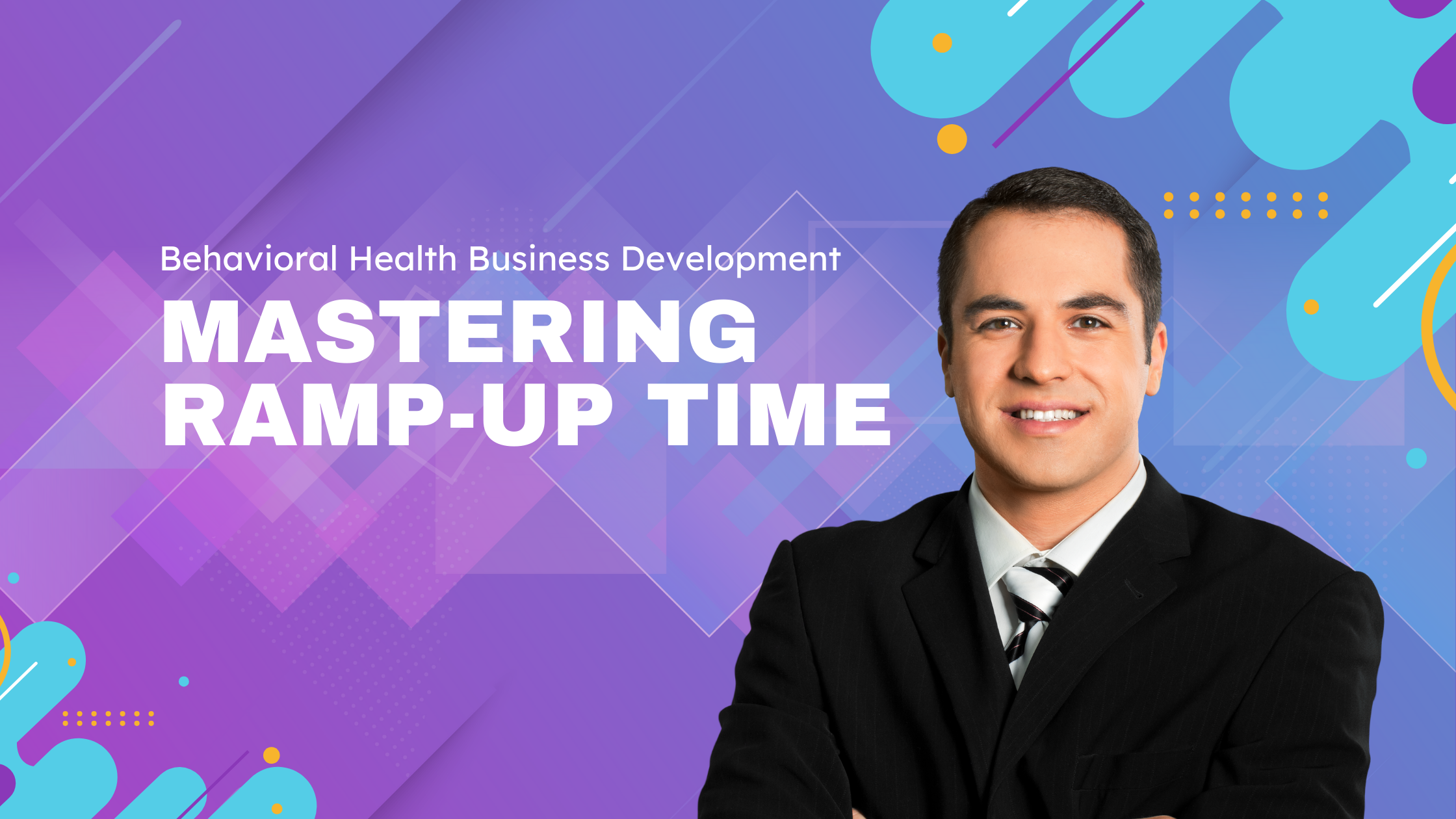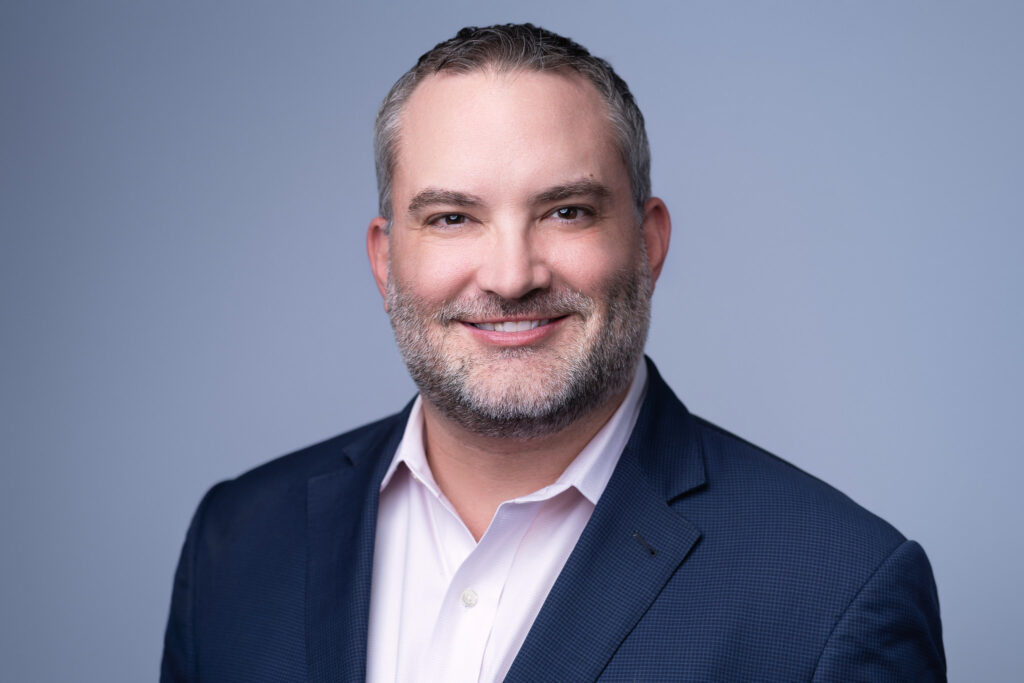
Behavioral Health Business Development: Mastering Ramp-Up Time
By David Farache
September 6, 2024
For the majority of outreach professionals in the behavioral health industry, targets and quotas loom large. The journey of a new outreach representative often begins with excitement and anticipation, fueled by a fresh role, a box of business cards, marketing materials, and organizational expectations. However, beneath the surface of this dynamic profession lies a crucial yet often overlooked factor that can significantly impact a business development rep's success: ramp-up time. In this article, we will delve into the intricacies of ramp-up times, the behaviors associated with different expectations, and the resulting return on investment (ROI) for businesses.
Defining Business Development Ramp Up For Behavioral Health
Ramp-up time refers to the period between the date of hire and the achievement of expected production levels. While production can vary, it typically involves generating sufficient revenue to meet the organization's targeted return on investment (ROI). Understanding ramp-up times is essential for both businesses and representatives. It provides businesses with a projection of when their investment in a new employee will yield results, while reps gain insights into the behaviors necessary to meet their targets.
Why does this matter?
Well, for the rep’s planning this is wildly important. A typical rep in the behavioral health space has anywhere between 500-1500 viable referral sources within their territory. This could include any vertical market and any potential referral volume. Understanding the ramp-up expectations determines how that rep manages that territory.
Case Study: Treatment Rep A vs. Treatment Rep B
To illustrate the impact of ramp-up time, consider two reps hired on the same day by treatment programs in the same market. Treatment Rep A has a 120-day ramp-up to reach two admissions per month, while Treatment Rep B has only 30 days.
Treatment Rep A will be inclined to do two behaviors specifically to achieve those goals. Behavior 1 is diversifying account mix. Rep A is able to work slower referring accounts, such as unions and hospitals, because they know they have the time to have at least 3 meetings prior to hitting their target. Accounts like this typically take that amount of contact as a minimum prior to referring. The second behavior Rep A can do is focus on A & B level accounts – the higher referring accounts. Similarly, these accounts all have options for where they send patients and generally don’t switch easily. These type of accounts take several meetings, site visits, etc. to gain a significant chunk of their business. With the time to do so, Rep A is able to mix in a healthy amount of these accounts into their account plan.
On the other hand, Rep B has to produce quickly. They aren’t afforded the time to put lots of energy into A accounts or vertical markets that take more time to materialize. Rep B has to immediately become a transactional rep which in behavioral health generally means focusing on one vertical market in particular – other treatment centers. Rep B will have to spend their time meeting solely with other BD reps and admissions teams to get referrals, and generally are only able to do so with an expectation of reciprocation.
Which Approach Yields Better Results?
While it's challenging to definitively quantify the performance of each approach, several key factors come into play: turnover, admissions fluctuations, and ramp-up production.
Rep A could begin exceeding those targets within 30 days, nullifying the need for the ramp up. Rep B could be an exceptional outreach rep who is able to generate admissions quickly and sustain that level of production. Before deciding upon which rep is the better decision, let’s take a look at symptoms of these decisions, not just at the singular rep level, but as a team of outreach representatives.
Turnover
Hubspot reports average rep turnover for sales personnel is around 35%. Personal experience shows that turnover for the team with a longer ramp-up is dramatically lower with recent experience showing turnover below 10%. For a team of 20 outreach reps, 35% turnover at an average salary of $85,000 can cost a company $300,000+ per year in both soft and hard costs. Soft costs being associated costs such as recruiter fees, labor to interview for new roles, labor for onboarding, etc while hard costs can be things such as a direct hit to revenue due to lack of production from an open territory. Reducing that turnover number to 10% saves the company around $260,000 annually. $260k even moderately invested back into patient acquisition is at least $1mil worth of new top line revenue. All that, just by reducing outreach rep turnover.
And That’s just year one. Moving forward, the positive effect of keeping employees multiplies. Not only does the company save on all the costs like lost productivity, recruiting, contractors, etc., but they also get the compounded effect of more tenured reps generating more revenue. Now the added benefit to the $260k savings is more production at the top line from the same staffing level as before.
Admissions Fluctuations
The challenges with acquiring business from longer sales cycle accounts/vertical markets can be negated over time by consistency. Behavioral health, in particular, has cycles that much of the industry assumes is natural, when it is in fact a symptom of a behavior. For example, is all addiction and alcoholism cured in December? Of course not. As an industry it’s generally accepted that December will be a slower month, but it doesn’t have to be slow. That’s the benefit of having an account mix comprised of A accounts and vertical markets that do not rely on internet search for leads (unions, hospitals, etc). To add to that, not only having that account mix but also having deep and respected relationships with those accounts. That way, the reps in this system are the first choice for referrals when those accounts need to send a patient to treatment. Being the first choice is wildly important for consistency as the aforementioned target accounts are inclined to reduce referrals to others during “slow times,” but will remain a consistent referral pattern to their top choice. What’s not to like about that?
The other factor that comes into play for organizations suffering from peaks and valleys of census is staffing. How do you consistently staff an 80 bed program if some month’s census is at 40 and other months it’s at 75? Staff for 40 and you don’t care for patients during times of targeted census. Staff for the middle, say 65, and you’re overstaffed for 40 (wasting money), but understaffed for full census. Staff for 75 and labor costs will dramatically outweigh the revenue from times of low census. This is an obvious issue.
Furthermore, if understaffing is the choice a program will inevitably run higher AMA risks (patients leaving early Against Medical Advice), lower average length of stay (ALOS), and thus dramatic decreases in revenue. For just one example using this 80 bed program, a typical 30 day program running at a target of $1000 per day could lose up to $2 million annually by an average drop of ALOS of just two days per patient. Does that outweigh the increased admissions that shorter ramp-up typically brings the program? That’s up to the individual program to run the math.
Ramp-Up Production
It’s not all roses for the longer ramp-up option. Even with a projected higher turnover, Company B (and thus rep B), will typically have a higher number of admissions year 1. Running several models utilizing a team of 10 reps showed this again and again. If the singular goal is to get to high census quickly, then this method will do that given the organization does hire several reps to hedge against turnover. For organizations that just opened their doors or have experienced an event that dramatically dropped census and now need a quick rebuild, this method could be the better short term plan.
However, when taking into account the aforementioned soft cost issues, as well as the inevitable peaks and valleys of census (and impact on staffing, ALOS, etc), it’s difficult to recommend a shorter ramp-up as the best overall plan for a treatment center’s productivity.
Conclusion
In the realm of behavioral health business development, understanding and optimizing ramp-up time is crucial for achieving sustainable success. Often BD admissions and productivity is looked at in a vacuum, and unfortunately the benefits and consequences of BD goals, structure and expectations are looked at outside of the whole ecosystem of a treatment center. Taking this holistic approach to revenue generation over time should not only remove some of the consistent headaches of facility management, but it should also provide a level of stability and predictability that can stabilize an organization, thus improving the opportunity for better patient care. Therefore, it’s safe to conclude that providing a larger investment on the proper development, and thus ramp-up, of a business development representative is going to provide a larger ROI across all aspects of the company, even though top line admission totals might lag early on.

About Steve Donai
Steve Donai, founder of Growth Sherpa Consulting, is a business development executive with more than two decades of successful sales and leadership experience. His career working in behavioral healthcare fulfilled a passion for using his sales knowledge to make a positive impact on the patients and families trusting the company he served.
With more than a decade of behavioral healthcare-focused experience, generation of over $250 million of revenue, oversight to 14,000+ admissions, and the development of dozens of leaders within the behavioral health space Steve decide to create Growth Sherpa to offer his unique coaching and professional development methods to assist business development leaders.
Growth Sherpa is different because of the understanding and purpose-driven approach to the challenges programs face. We will partner alongside your leaders to find solutions so programs can focus on what is most important — providing excellent patient care.
With this purpose, Steve has put together a team of behavioral healthcare professionals at each level of your patient acquisition operations. So whether you need a staff level employee to put together a prospect list in a new market, a sales director to oversee your outreach team, or an executive leader to work directly with leadership to ensure all parts of the revenue generation ecosystem are working in harmony Growth Sherpa will have the bespoke plan created for your organization

